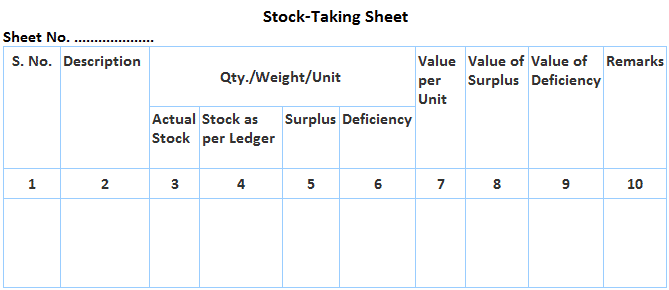The standard procedure for stock verification is as follows: 1. Prepare a program of verification. 2. Receive approval from the appropriate authority. 3. Appoint the verification team. Note: In continuous stock verification, the staff is permanent and, in fact, under this method, there is no appointment of the verification team. However, under annual stock verification, the following staff are appointed to the verification team: 4. Provide the verifiers with a timetable and stock-taking sheet, which is usually serialized and dated. 5. Record notes and other details on the stock-taking sheet with the help of available documents. 6. Physically check and verify stock. 7. Note any discrepancies. 8. Value the stock. 9. Dispatching the necessary certificates, reports, and recommendations. A stock-taking sheet is a printed form that is provided to the verification team. It enables stock verification to be convenient, systematic, and foolproof. After the process is complete, the findings are summarized and reports are prepared. The total value of the stock is also calculated with the help of the stock-taking sheet. The following is the proforma of the stock-taking sheet: 1. Quantity Taken by ........................... 2. Quantity Checked by ...................... 3. Prices Inserted by ........................... 4. Extension and Additions Inserted by ................. 5. Extension and Additions Checked by ................ 6. Values of Stock Certified by ............................... 7. Examined by....................................................... After the completion of stock verification, a stock valuation sheet is prepared to consolidate all stock-taking sheets. This helps to calculate the value of the materials in hand. A proforma of the stock valuation sheet is given below.
Stock-taking Sheet

Stock Valuation Sheet

Stock Verification Procedure FAQs
A stock-taking sheet lists all items purchased for a specific period of time. The proforma includes details such as name of the supplier, quantity purchased, price paid per unit, etc. A stock valuation sheet summarizes all results from individual stock-taking sheets and calculates the total value of all items.
All organizations should have a system in place to check and verify stock on a regular basis according to local conditions and requirements. For example, if a company receives a monthly consignment of materials, then it will have to physically verify that all goods have been received by the last day of the month. If the verification is not carried out on time, then any goods received after that date will not be included in the actual quantity of materials on hand.
A physical stock count needs to be completed on a regular basis, usually monthly or quarterly. The physical quantity of stores should be checked against the number of items recorded in the store ledger and order records. A thorough review should also involve checking current stock against the previous year's valuation to ensure that there are no major discrepancies.
Verification is usually carried out by a member of the accounting or auditing team, who can review all records and compare them with an actual physical count. The audit department could be used if the company has one in place. If the company does not have an audit department, then a staff member from accounting or purchasing could be asked to carry out stock verification.
The entire process of inventory counting should take place in a well-lit and clean environment that is free of dust and other contaminants. All items should be checked one by one and the count should match with data from records such as invoices, packing slips, delivery dockets, etc.
True Tamplin is a published author, public speaker, CEO of UpDigital, and founder of Finance Strategists.
True is a Certified Educator in Personal Finance (CEPF®), author of The Handy Financial Ratios Guide, a member of the Society for Advancing Business Editing and Writing, contributes to his financial education site, Finance Strategists, and has spoken to various financial communities such as the CFA Institute, as well as university students like his Alma mater, Biola University, where he received a bachelor of science in business and data analytics.
To learn more about True, visit his personal website or view his author profiles on Amazon, Nasdaq and Forbes.











